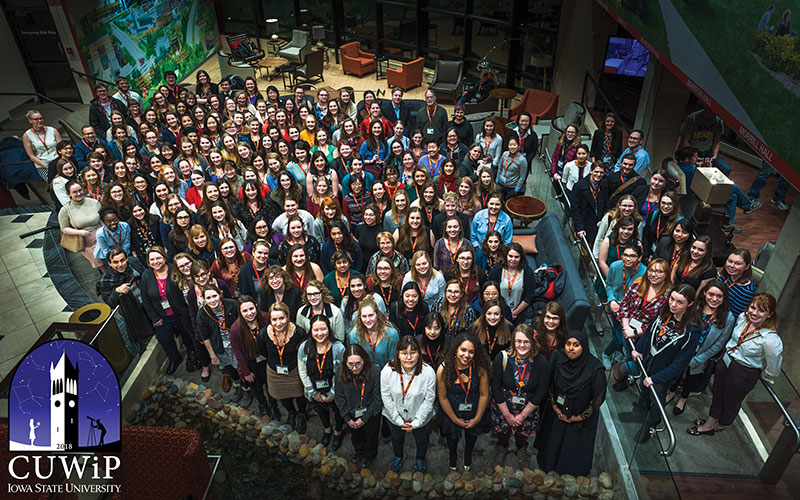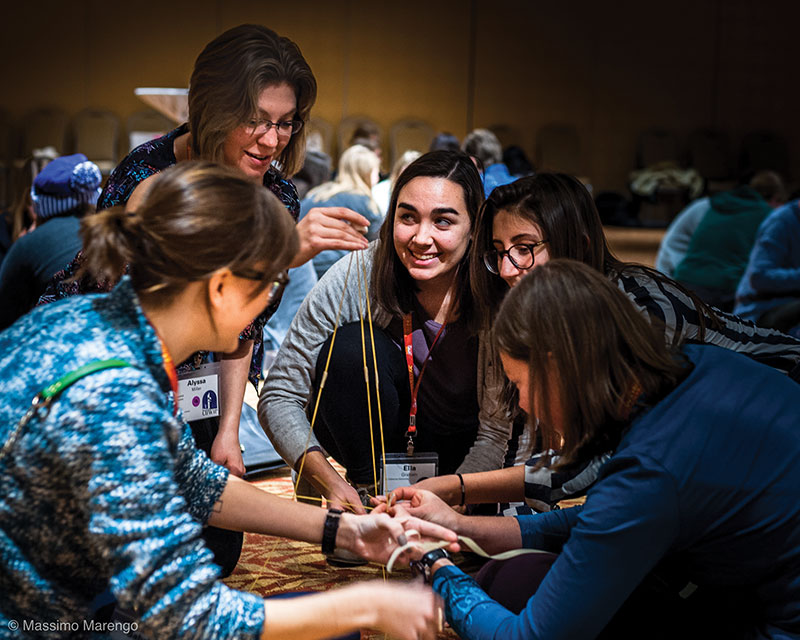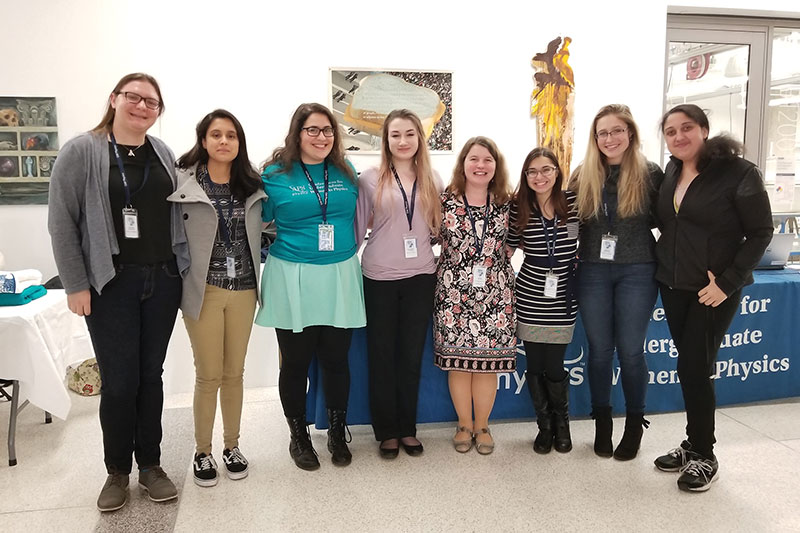CUWiP 2018: Continuing the Tradition
Spring
2018
Meeting Notes - SPS Reporters at Science Conferences
CUWiP 2018: Continuing the Tradition
From CUWiP, Iowa State University
by Ariel Crego, SPS Member, Coe College
“If I do things other than physics, they won’t think I’m serious about it. That’s not true.”

These words, spoken by Dr. Ágnes Mócsy, couldn’t have better reflected my own attitude. My two areas of study—physics and creative writing—tend to elicit raised eyebrows. I was only able to combine them thanks to Coe College, where exploration of various fields of study is heavily encouraged. And while I know many students who pair science with mathematics, language, or cultural studies, there have been only a handful of science and writing majors before me.
Throughout the years I’ve had a back-and-forth with myself about the validity of my interests, and only recently have I been introduced to science communications as a career path, albeit one with no clear-cut road. This led me to apply for the 2018 Conference for Undergraduate Women in Physics (CUWiP) at Iowa State University in Ames. My first conference was a CUWiP, and it made me see that I could be a woman of science despite all my inhibitions and insecurities. It helped me gain the confidence to stay with physics, and I wanted to do any small part I could to help someone who might feel the same way.
During the first full day of the conference, about 200 physics students from various colleges and universities piled into the spacious Benton Auditorium. Murmurs and snippets of conversation bounced off the walls. There was lots of early morning chatter and people on their first cup of coffee for the day.
Dr. Ágnes Mócsy, professor of physics and astronomy at Pratt University, took the stage, and there was no one more fit to start the morning. Mócsy works with the building blocks of the universe, those particles that existed at the time of the big bang and those that still build everything around us. But it was the moment when she turned to the intersection of physics and art that I still hold onto.
Around me I saw people shifting forward, eyes lighting up and mouths opening in exclamations of awe. Mócsy showed photos of art created with physics in mind—hats modeled after the post–big bang explosion of particles, earrings shaped like gluons, beautiful paintings and sculpture modeled after cosmological structures studied around the world, dresses with “red-shift, blue-shift” detailing that shimmer and sparkle in the light.
In that moment, it began to come together for me—and for many others around the room. Any woman in science knows that one must not appear too feminine, lest male colleagues not take us seriously. Yet, here in front of us was a woman who is highly respected in the community, who has worked at Brookhaven, Yale, and the Niels Bohr Institute but is also a fashion designer and filmmaker. While art is not intrinsically a woman’s field, there is the perception that art and science don’t mix—and that’s simply not true.
For the rest of the conference Mócsy was surrounded by people sharing stories of their own desires to create “artistic science.” I had the opportunity to speak with many of them throughout the conference, and the hope they gave me for the future is immense. There was even a pair of students from the same school, both majoring in physics and art, who had no idea the other existed until this conference. My takeaway: No one should feel that they must be purely science-oriented to be a successful physicist.
The conference also emphasized networking and connecting. When you’re the only girl in the class, it’s easy to forget about the hundreds of other women in the field. But suddenly being thrust into a room with so many of them can be daunting. Parallel sessions allowed us to make personal connections while also learning about combating bias, imposter syndrome, and taking on leadership positions.
On our drive back to Cedar Rapids, my peers and I chatted about ways to introduce new ideas and concepts to our professors, as well as events, activities, and collaborations that our campus Women in STEM organization could host. I can only imagine that the departure for many other attendees was similar, and I hope that anyone who may have been unsure of their place in physics left with a clearer idea of their own future.


From CUWiP, George Washington University
by Sarah Monk, SPS Member, University of Maryland
The 2018 Conference for Undergraduate Women in Physics at George Washington University wasn’t the first CUWiP that I’ve attended, but as a graduating senior, it will likely be my last. I was fortunate to experience my final CUWiP with an amazing group of women, including several from my home institution, the University of Maryland. It was the first CUWiP for most of them, and I was thrilled to see the enthusiasm and empowerment on their faces over the course of the weekend.
The conference kicked off with a tour of the NASA Goddard Space Flight Center before the official opening banquet. It was a wonderful dinner, with heartfelt welcomes from Evie Downie, representing the conference organizing committee, and representatives from GWU and APS. My table was lucky enough to be seated with after-dinner speaker Christine Jones of the Harvard-Smithsonian Center for Astrophysics. It was great to speak with her in a less formal setting and hear about some of her experiences. Those at our table studying astronomy even learned that she had developed the software used in their astronomy courses.
The next morning’s plenary speaker, Dr. Kawtar Hafidi, was an experimental nuclear physicist currently serving as director of the Argonne National Labs Physics Division. We learned of her upbringing in Morocco, her travels around the world, and how she achieved her position through hard work, while also balancing her life as a wife and mother.
Our first panel discussion, “How to battle issues of diversity, bias, and intersectionality: Mentoring and building a diverse community,” was for me one of the conference’s most impactful. Hearing first hand from women who’ve overcome so many struggles to get where they are really stood out to me.
Next, we jumped right in to the poster session, later celebrating two fellow undergrads from UMD who won poster awards: Stephanie Williams took second place, and Junellie Gonzalez-Quiles took third.
Much of the rest of the afternoon was spent with parallel panels and workshops on career development. It was refreshing to see the wide range of careers that GW drew attention to and to know that, as physicists, we have many options. That afternoon, the APS keynote speaker, Dr. Patricia Burchat from Stanford, told the inspiring story of her path from first-generation high school graduate to the top of her field in experimental particle physics and cosmology.
Sessions wrapped up with an entertaining outreach fair led by GWU faculty member Gary White, who specializes in physics education, and the local Society of Physics Students chapter, which gave everyone the chance to unwind with physics demos and games. We closed the day with Physics Jeopardy before everyone headed back to the hotel, exhausted after a fun-filled day.
Our final day included plenary talks by Nancy Jo Nicholas from Los Alamos National Laboratory and Dr. Luz Martinez-Miranda from the UMD materials sciences department. The panels and workshops focused on life as a physicist, addressing graduate school life, work/life balance, LGBTQ+ experiences, and health and self-care. I was sorry not to be able to attend them all.
As our CUWiP came to a close, we all said our heartfelt goodbyes and thank yous. Attending these conferences has truly been a favorite event in my academic career. I hope that every young woman entering the field gets the chance to experience the camaraderie, solidarity, and empowerment that goes along with it. //

